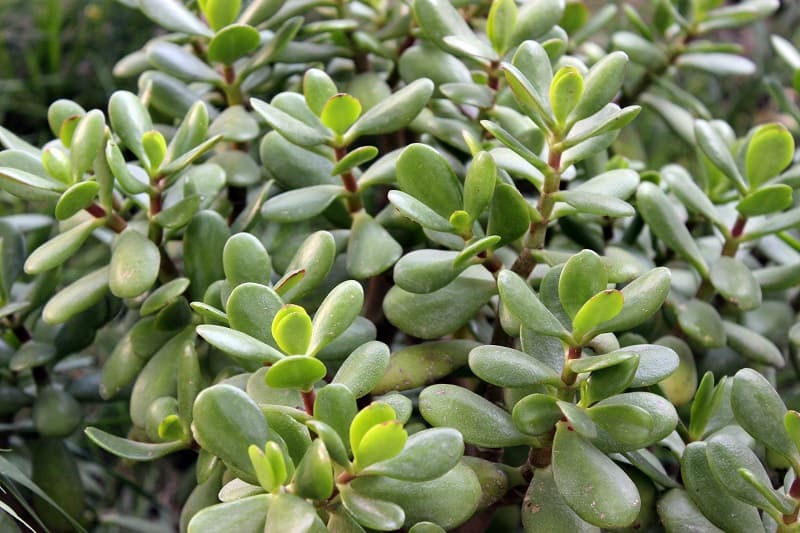
Jade plants, or Crassula ovata, are also commonly called money plants, money trees or lucky plants. These plants are native to South Africa and Mozambique and are popular houseplants sometimes given as housewarming gifts for good luck. Being succulents, they are more susceptible than most plants to overwatering. This article discusses the symptoms of overwatering, and how to save your jade plant if you have overwatered it.
Symptoms of an overwatered jade plant
The leaves are turning yellow.
An overwatered jade plant will have yellowing leaves. Older leaves that turn yellow and are replaced by new leaves are a normal occurrence; however, if you notice that large numbers of both old and new leaves are turning yellow, it could mean that you have a watering problem.
The leaves are falling off.
Plants that are overwatered will start to shed their leaves. This is an indication that the root system is struggling and can no longer support the leaves, and it is possible that root rot has set in. Falling leaves could also be due to the wrong soil, pests, underwatering, or insufficient light.
Shedding of older leaves is usually part of the normal life cycle, but if the leaves are falling off in large numbers and the shedding extends to younger and smaller leaves, it should be a cause for concern.
The leaves are soft.
An overwatered jade plant has soft, mushy leaves. Succulents like jade plants are used to hot climates and desert areas and store water in their stems and leaves, giving them their plump appearance. They do not need constant watering and should only be watered when the soil has completely dried up.
Overwatering causes the plant tissue to become over-filled with water, which is what causes the soft and mushy appearance of the leaves.
The leaves are drying up.
An overwatered jade plant may also have leaves that are drying up. This happens when there is a problem in the roots. If the soil is soggy but the leaves are dry, it could mean that the roots are drowning in waterlogged soil and are therefore unable to absorb water and nutrients for the plant.
The soil is wet and the roots are rotting.
Succulents like jade plants are susceptible to root rot if they are overwatered. If the roots are unable to take in oxygen and nutrients from the soil due to the constant bogginess, they will die and become susceptible to root rot, which is caused by bacteria and fungi that feed on the drowned roots.
If the soil is heavy and soggy, it is most likely overwatered. You may need to remove the plants to check the roots; if they are wet, slimy and covered with black sludge, they have root rot.
How to save an overwatered jade plant
You can still save your overwatered jade plant if the damage is not too severe. Carefully remove the affected plant from its container and remove the waterlogged soil from around the roots. Do this gently so as not to aggravate the roots, and inspect the roots to assess the extent of the damage.
Next, remove any rotten roots by cutting them away with a pair of sterile pruning shears. Cut back any that are black or brownish in color; healthy roots will have a white center. Once you are left with only the healthy roots, make another cut into each of these roots to encourage new growth and help the plants recover.
Once you have removed the rotten roots, repot the jade plant in fresh, nutrient-rich soil. You may have to use a smaller pot, since there are fewer roots. Succulents prefer containers that are just large enough to accommodate their root structure, and containers that are too big lead to overwatering.
Make sure that the soil is well-draining; ideally it should be a blend of organic and inorganic materials. Do not use conventional houseplant potting soil. The containers should have drainage holes so that excess water can flow out easily. Once you have repotted the plants, leave them for a few days and do not water until you are sure that the roots have completely dried out.
When you water the plants, do not overdo it. Tip any excess water from the pots and do not leave the plants soaking in water. The frequency of watering will depend on the environment and the area where you live. Most succulents are fine with a good soak once every three weeks, or when the soil has completely dried out.
Conclusion
Jade plants are popular houseplants also known as money plants or lucky plants. Being succulents, they are more prone than most to overwatering. You can easily tell that a jade plant is overwatered if you notice its leaves turning yellow, falling off, or becoming soft and mushy. You may also notice the roots starting to rot. Fortunately, it should not be too difficult to save your overwatered plant, as long as you act promptly.
Image: istockphoto.com / Nuarevik